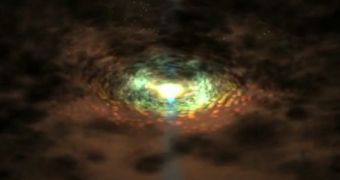The latest observations of active galactic nuclei, conducted with the NASA Rossi X-ray Timing Explorer (RXTE) satellite, have revealed additional clues on the transport mechanisms supermassive black holes use to channel matter inside very large gas clouds through their event horizons.
An event horizon is a hypothetical threshold around a black hole, beyond which matter can no longer escape the intense gravitational pulls these behemoths exert on their environments. Supermassive black holes, millions to billions of times heavier than the Sun, are capable of gulping up vast amounts of matter, but only a limited amount of matter can pass through the event horizon at once.
As such, structures called accretion disks form. These formations are basically clouds of matter spinning around the dark behemoth's equator, constantly accumulating gas and dust. Due to intense friction, temperatures inside these disks can exceed millions of degrees, which leads to the emission of vast amounts of X-rays and gamma rays.
Supermassive black holes whose accretion disks contain unusually high amounts of matter and release extreme volumes of radiations are called active galactic nuclei (AGN). Until now, astronomers did not know how these structures were able to provide themselves with enough sustenance.
The new RXTE study helped experts come up with a solution, by shedding some light on the long-distance transport mechanisms that channel matter towards the accretion disk, from huge distances away from the black holes. Single large clouds of dust, some larger than our solar system, appear to play an important role in feeding these insatiable structures.
By analyzing how high-energy radiation emissions from AGN cores dim from time to time, RXTE was able to determine that three times more gas clouds exist around these black holes than previously estimated.
“One of the great unanswered questions about AGN is how gas thousands of light-years away funnels into the hot accretion disk that feeds the supermassive black hole. Understanding the size, shape and number of clouds far from the black hole will give us a better idea of how this transport mechanism operates,” says Alex Markowitz.
The expert holds joint appointments as an astrophysicist at the University of California in San Diego and the Karl Remeis Observatory in Bamber, Germany. Details of the study will appear in an upcoming print issue of the esteemed journal Monthly Notices of the Royal Astronomical Society.
The research was able to determine that these occulting clouds average 6.5 billion kilometers (4 billion miles) in diameter and usually weigh around two Earth masses. Their orbits stretch from a few light-weeks to a few light-years away from the black holes powering up the AGN.
“Because RXTE performed sustained observations of many of these AGN, our research is sensitive to a wide range of cloud events, from those as brief as five hours to as long as 16 years,” concludes Andrés Bello University theorist and paper co-author Robert Nikutta.

 14 DAY TRIAL //
14 DAY TRIAL //